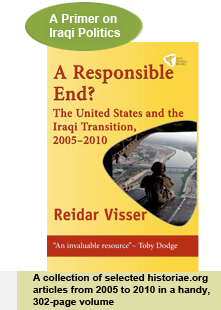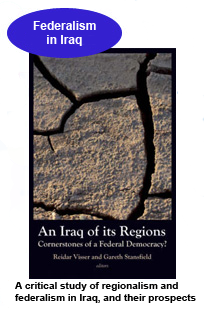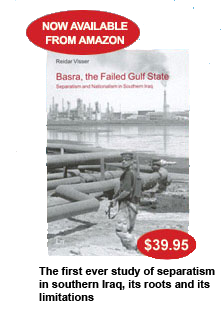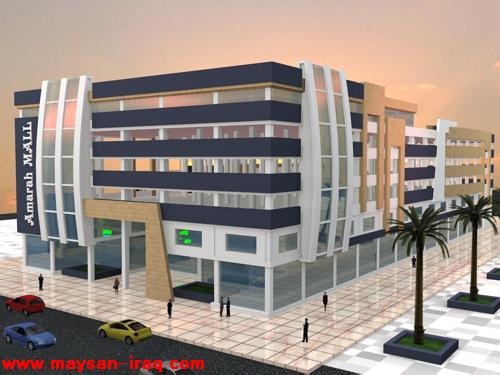



| Main | |
| Documents & images | |
| Links | |
| Contact | |
 | |
| amazon.com |

|
|
|
amazon.com
amazon.co.uk |
|

|
|
|
amazon.com
amazon.co.uk |
|
The Sadrists, the Bush Administration's Narrative on Iraq, and the Maysan Operations
By Reidar Visser (www.historiae.org)
3 July 2008
Last week, on 25 June, a curious essay on Iraqi politics made its way to the op-ed pages of The New York Times. In it, Thomas L. Friedman drew up a rosy picture of how the supposed “Shiite mainstream” and “mostly secular-oriented Shiite majority” in Iraq is currently in the process of “liberating” the last remaining pockets of opposition, as Maliki’s government pursues military operations against what Friedman describes as “Mahdi Army militiamen and pro-Iranian death squads” in places like Basra, Sadr City and Amara (the provincial capital of Maysan). Friedman’s latest offering provides a crisp and eloquent summary of the Bush administration narrative on Iraq, especially concerning who are seen as true “moderates”: Maliki and the Islamic Supreme Council of Iraq (ISCI) are construed as good, Iraqi nationalist and even secular; the Sadrists are portrayed as Islamic extremist evil-doers with Iranian sympathies.
Many of the problematic assumptions of Friedman’s and the Bush administration’s reasoning have already been challenged. For example, the leaders of the principal Shiite party in the Maliki government, ISCI, continue to travel freely in and out of Iran, even for medical treatment, suggesting that they still have perfect confidence in the regime that created their party in 1982 with the sole objective of maximising Iran’s influence on the Iraqi opposition. To put it briefly, Iran is a regime known for going after its enemies; had Hakim’s policies in Iraq constituted any kind of problem then Tehran would have dealt with it.
Similarly, the contention that ISCI is more “moderate” than the Sadrist when it comes to the imposition of Islamic norms is misleading. For example, after 2003 ISCI was at the forefront of the Islamisation of Basra (often cooperating with the notorious Tharallah), and even Adil Abd al-Mahdi, ISCI’s most pro-Western figure and presumably an exponent of what Friedman sees as “secular Shiism”, is on record as saying that church and state cannot possibly be separated in Iraq. ISCI and the Sadrists may differ when it comes to what particular aspects of Islamic law they choose to highlight and seek to enforce, but there is overriding consensus on the idea of a Sharia-based society and the monopoly of the higher clergy in interpreting Islamic traditions.
As for “special groups” among the Sadrists, they appear to be just that – special groups. Had the mainline Sadrists been prepared to work with the Iranians, the movement as a whole would probably have changed its position. Instead, Sadrist leaders keep complaining about Iranian attempts to divide and rule them by implicating them in attacks on the Americans. The parliamentary contingent among the Sadrist has repeatedly shown itself committed to the political process, and it was they, along with other Shiite and Sunni forces opposed to the Maliki government, who in February pushed through the demand for early provincial elections – against the determined opposition of Friedman’s “moderates”, who fear the prospect of losing their fiefdoms in the provincial administrations.
What is the relevance of Friedman’s ideas with regard to Maysan and Amara? By reducing the Sadrists to “pro-Iranian Shiite extremists [who] tried to impose a Taliban-like order”, he completely overlooks a potentially more benign aspect of Sadrist activity in the far south, where they have governed Maysan since the spring of 2005. In the Sadrist perspective, the current targeting of high-level Sadrist officials is unjustified (the arrest of the governor himself has been reported but has also been declared untrue by his office), and they choose instead to focus their discourse on the high rating given to Maysan in reports by the Iraqi ministry of planning concerning the implementation of development projects in recent years. As Friedman appears to believe that the single objective of the Sadrist movement is to enforce Islamic law, it can be useful to take a look at some of the Sadrist development initiatives in Amara over the past years. They include plans for new university and hospital buildings, as well as a multi-storey car park in downtown Amara. If this activity is all a smokescreen for more sinister activities, then the catalogue of projects illustrated below is surely an impressive cover-up.

Maysan university

Multi-storey car park

New hospital building
This is not to suggest that the Sadrists of Maysan are in any way faultless, or that they are generically Iraqi nationalist and therefore incapable of even thinking of cooperation with Iran. While it should never be forgotten that the Sadrists are Tehran’s historical main enemy among the Shiites of Iraq, it is also the case that activity across the border in Maysan has been quite intense since 2003, and the governorate has taken steps to facilitate such contacts. But this resumption of cross-border trade after decades of artificial isolation needs to be put into perspective. The flows of money and investments from Iran to ISCI-controlled Najaf, for example, have been far more impressive. And even if the Iranians may have been successful in their policy of dividing and ruling the Sadrists by luring individual Sadrist operatives away from the mainline movement, this does not mean that the movement as a whole has converted to a pro-Iranian policy, or that Iran necessarily has abandoned its traditional policy of using ISCI as its primary tool. Even the Maliki government’s current project of negotiating a security deal with the Americans could in theory make sense to Iran: either Maliki could arrive at a deal with a limited time framework (which would keep US forces busy in Iraq for a while as they help solidify Maliki’s grip on power and thereby isolate Tehran’s traditional enemies among the Sadrists), or Iran could win time as it waits for a new US administration more disposed to striking a “great bargain” on Iraq.
Yet another problem in Friedman’s theorising concerns his ideas about where exactly the Shiite Iraqi mainstream is located. In a remarkable development, during the past few days Sadrist websites have been filled up with reports on the Grand Ayatollah Ali al-Sistani’s views on the need of reaching agreement on the forthcoming provincial elections, along with guarantees with respect to his neutrality and his disapproval of the use of his likeness in election propaganda (once more the process of preparing the elections has stalled because of delays in passing the required legislation). This comes after weeks with determined attempts by ISCI to have a clause removed from the draft for the provincial elections law in which this kind of usage of religious symbolism was prohibited. ISCI went out of its way during parliamentary deliberations and even cited widespread illiteracy in Iraqi society in support of their demand that the use of religious symbols be permitted. But in a typical expression of the media tendency to automatically label the Sadrists as the more fundamentalist of the two groups, the wire reports from Iraq are already describing a rumoured decision to stay with the original ban on religious symbols as a loss for the Sadrists!
Developments in both Maysan and at the national scene once more emphasise the complex nature of politics in Iraq. They also suggest the hollowness of Thomas L. Friedman’s take on what is going on.
Copyright © 2005-2008 historiae.org & Reidar Visser
This document or quotes from it may be freely reproduced as long as www.historiae.org is credited as the original source.
